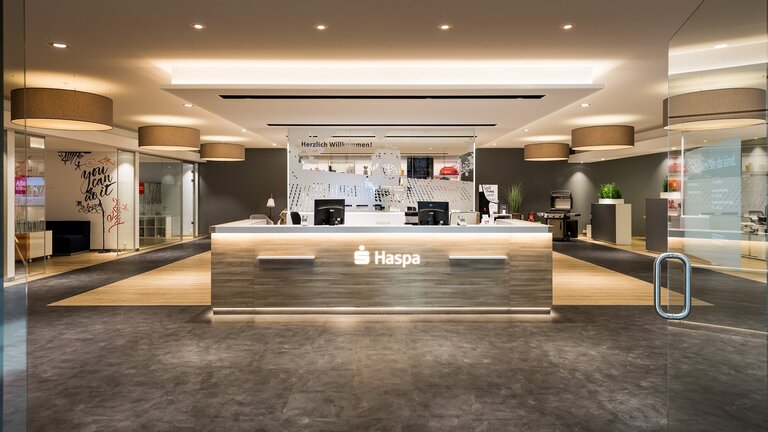Hamburg, Germany, November 18, 2021. The Hamburger Sparkasse (Haspa) savings bank has so far remodeled more than 90 branches, with the intention of developing closer ties with people and businesses in the neighborhood. Haspa invested a total of several million euros in remodeling its branches, which people can use not only for banking transactions but also for neighborhood events. The conversion project is being supervised by the planning and consulting company Drees & Sommer SE. The company with headquarters in the German city of Stuttgart is active in the construction and real estate sectors.
By converting its branches into a neighborhood meeting place, Haspa is reinforcing its strategic positioning as a digital bank with the best branches in Hamburg's metropolitan region. With the aim of becoming even more attractive to clients, Haspa views its branches as a vibrant part of an urban district that creates space for personal dialog, along with a feel-good atmosphere. For example, events ranging from eSports to art workshops, barbecue courses to burglary protection presentations, and online banking tutorials for seniors are held at the branches.
The redesigned Haspa branches also provide venues suitable for concerts and readings. Moreover, the financial institution offers free exhibition space for tradespeople, clubs, associations and enterprises from the surrounding area.
Successful Roll-Out through Value Engineering and Programmatic Approach
The biggest challenge for the project was the time factor. This is because each of the branches, with an average size of 450 square meters, were only scheduled to be closed for maximum ten days during the conversion work. This ambitious goal could only be achieved by adopting a comprehensive programmatic approach. ‘As a first step, we used value engineering to optimize the new branch design in relation to closure periods, making it ready for roll-out. As a second step, we then tackled the very complex roll-out structure with its multiple activities running in parallel. Together with Haspa, we developed a model process that could be transferred to each of the branch conversions as a blueprint. This resulted in a high degree of stability and transparency in the roll-out. This was the only way to manage the large number of projects concurrently and reliably,’ explained Tasja Schneider, Drees & Sommer’s project manager.
Lean Scheduled Planning Makes Short Closure Periods Possible
The Lean Construction Management method was used on the building site itself. As a result, all workflows are planned in detail, providing a precise overview of which team is on site in which timeframes. Communication is particularly important for this, both between the individual trades and between the building owners or developers, planners, engineers and tradespersons. In order to avoid delays in delivering materials and furniture to the construction site, Haspa used its own logistics hub together with a digital ordering process for the entire conversion project. To do so, the design planning with all furniture was transferred into a digital library using building information modeling (or in short BIM). This benefited procurement management especially, as it was then possible to order items from a database. ‘Overall, the branch conversion was an outstanding team effort,’ said Britta Anger, who coordinated the project on Haspa's part together with colleague Cindy Elgert ‘At times, more than one hundred people were involved in the remodeling process. Many of them were on site, taking turns on the construction site for very short periods of time and completing their tasks within a very tight timeframe. The coordination between internal and external participants went so well that we are now leaving our almost completed project with a tearful eye,’ commented Cindy Elgert.
Effect of the Covid-19 Lockdown
The only challenge was the coronavirus factor. Due to the lockdown and the resulting impact on global supply chains, the conversion was suspended in April 2020 as a precautionary measure, to allow for adapting the plans. ‘Discussions were held with all the parties involved in the project, while ordering deadlines and storage in the logistics hub were adjusted accordingly where necessary,’ explained Tasja Schneider. At the same time, fewer building sites were running in parallel, so there was always another construction team in reserve in case one was down due to the pandemic. Because of the precise lean scheduling already in place for each branch conversion, there was hardly any need for adjustment during the construction phase. We only had to spread out two peaks per construction phase, so that as few teams as possible overlapped on the construction site on those days, to minimize the risk of contagion. ‘We also overcame this challenge with flying colors, thanks to good teamwork,’ emphasized the project manager. The effort was worth it: the new branch design has been well received by Hamburg's residents. The neighborhood concept strikes a chord with people. This makes regional anchoring even more tangible, so Haspa is relevant to its neighbors in the district, far beyond the conventional banking business.’
